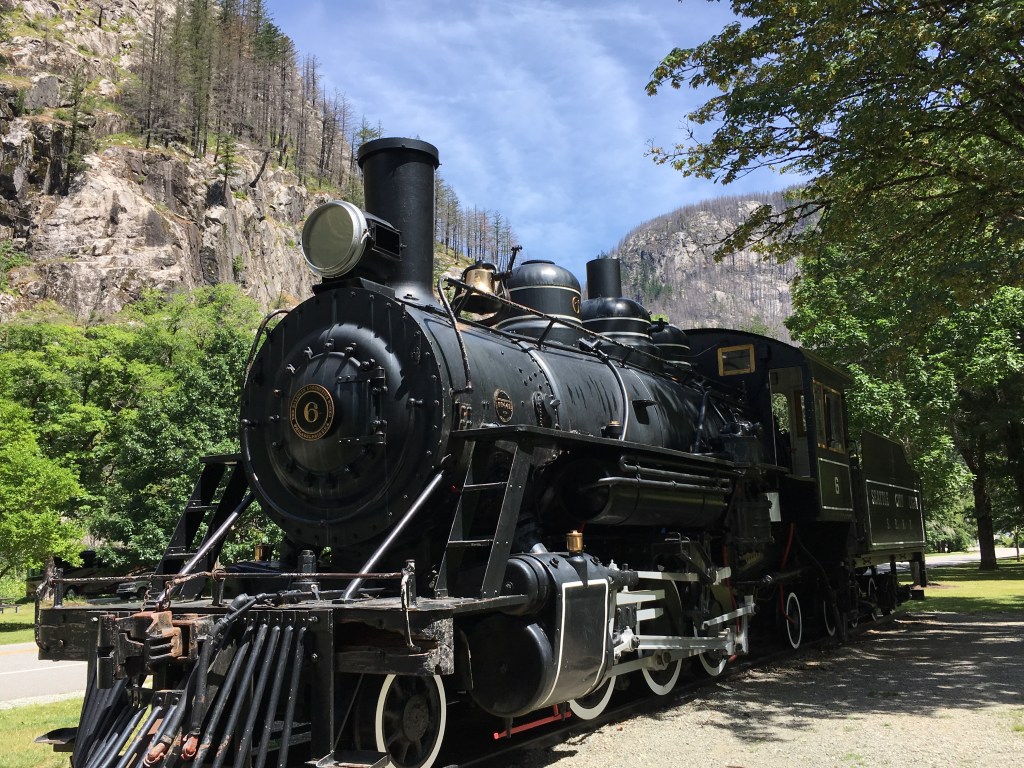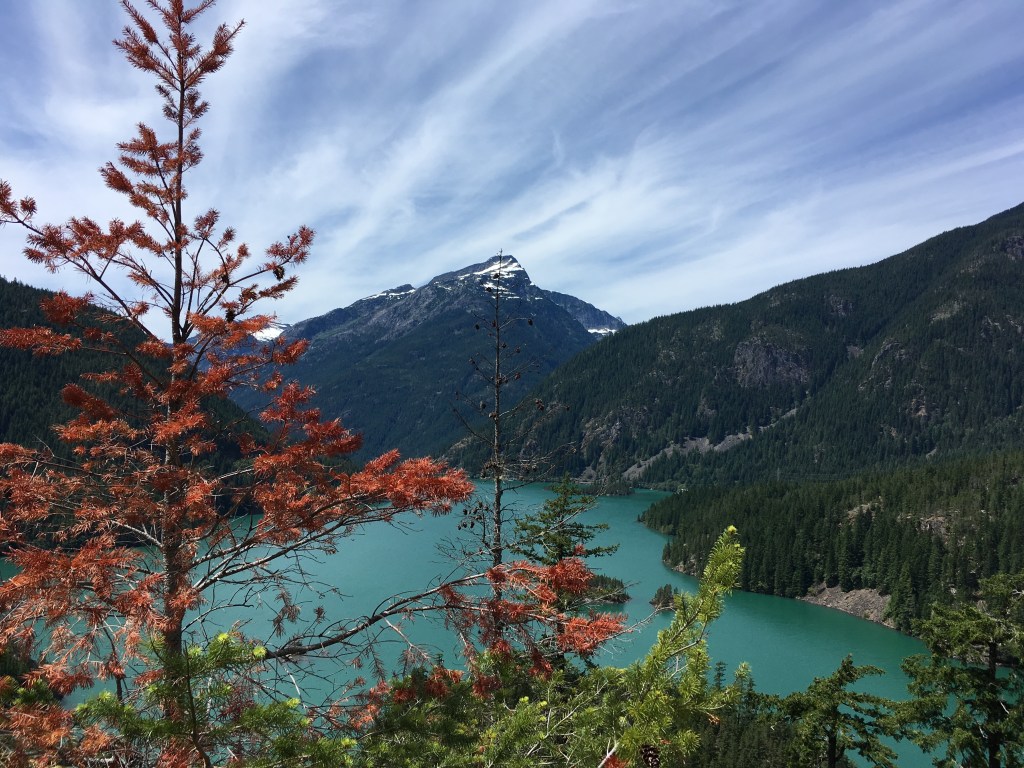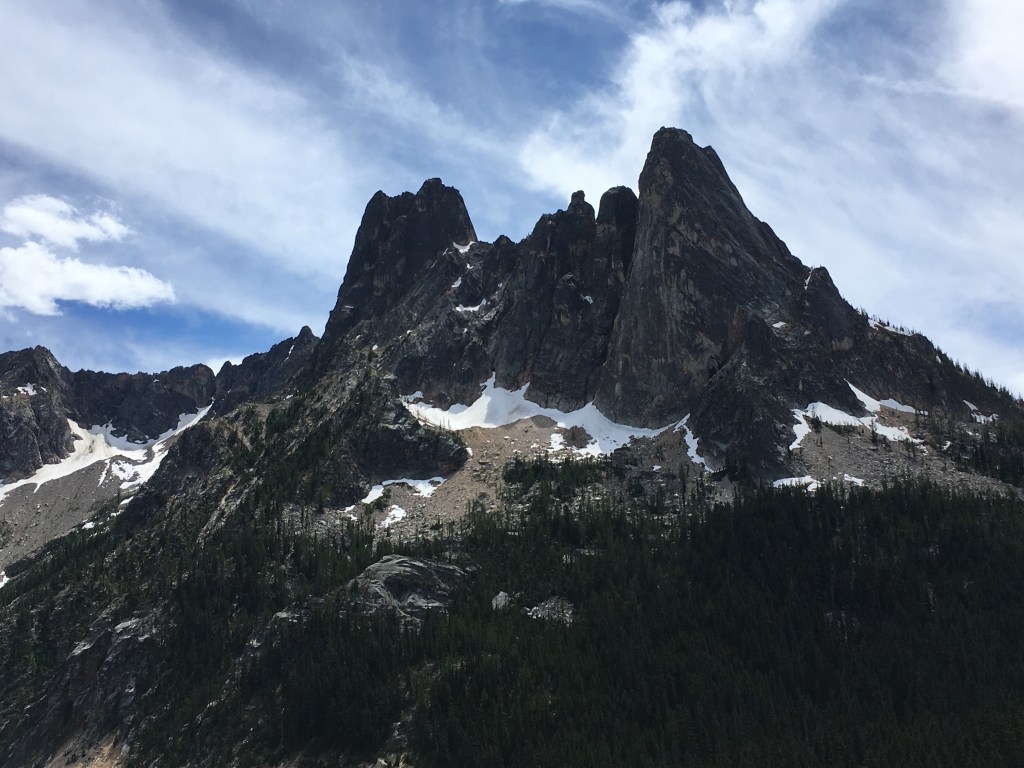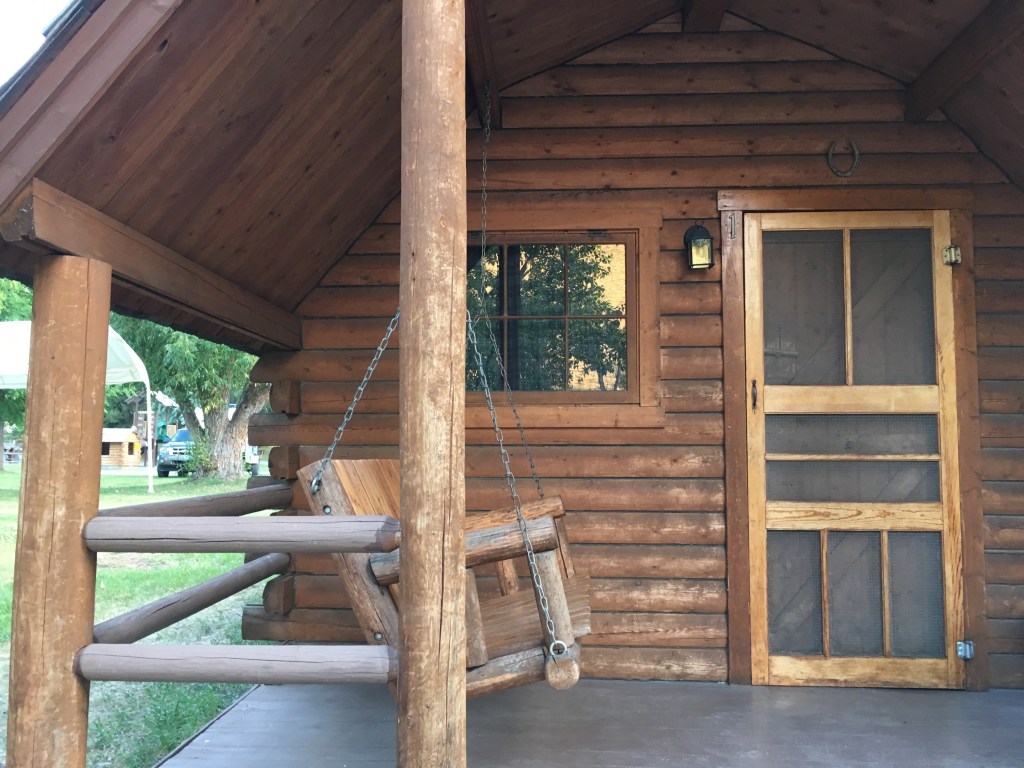I got an early start because I had slept in the car. There was no deconstructing the tent and packing up. I was ready to go. I went from sleep to the turn of the car key and I was on the road. Now it was time to pay a visit to another National Park: North Cascades National Park, which was only about an hour away. When people refer to the North Cascades, it’s similar to when referring to the Redwoods. As the Redwoods constitute a collection of state parks, North Cascades too is a collection. There are three major entities: Ross Lake National Recreation Area, Lake Chelan National Recreation Area and North Cascades National Park proper, though the latter name is just used to refer to all in the trio collectively.
I had big plans for this visit: an overnight backpacking adventure the following day in the Lake Chelan area. Today I would just be traversing the heart of the parks on highway 20, stopping at the visitor center, all the overlooks, and seeing what I could see. I had noticed in my investigation that all the iconic views of North Cascades were roadside viewpoints, so I figured I wouldn’t be missing anything essential.When visiting parks I’ve got to make sure I don’t miss out on the essential views. What a shame it would be to go to Yosemite and never see Tunnel View, or go to Yellowstone and fail to see Old Faithful.

My first stop was at the visitor center by the west entrance of the park. There I watched the park film, and a series of other films on smaller screens throughout the visitor center. The three National Park units that make up this area were all created in 1968. This park has glacial mountains, consisting of over 300 glaciers. Although it’s famous for its sharp mountainous peaks, called the Cascades, it got its name North Cascades, and I suppose the mountains too, from all the water cascading from the peaks, forming many streams and rivers. The water sources of the area were used for hydroelectric power, but the development of the National Park stopped the further industrial development. The park’s two most famous lakes, Diablo Lake and Lake Ross, are the result of man-made dams. Both lakes are extravagant in their bright turquoise color, which is created from rock particles. The National Park Service describes it best: “the distinctive turquoise color of the lake is the result of suspended fine rock particles refracting sunlight. These rock particles, called glacial flour, enter the lake when rock from the surrounding mountains is eroded by ice and flows into the water through glacial streams.”
After learning about everything in the visitor center, it was time to experience it all first hand. About ten minutes up the road I made my first stop. Nestled closely by mountains on either side, within a gorge, and right along the Skagit River, was this little town with modest homes and a few small businesses. It was strange to see manicured lawns, and intentional landscaping around buildings in a National Park. The only other thing it reminded me of was the town of Mammoth Hot Springs in Yellowstone, where many park rangers and staff take residence. But this town looks rather industrial with lots of electrical wires and utility infrastructure. I know this had to do with the dams and hydroelectric power, but it didn’t even cross my mind that the waterways in this park were still being used to generate electricity. I had assumed this was all a relic of the past, that it was a company town of a hydroelectric power company but the homes left over from that bygone era were now ranger residences. I thought this was a little ranger and park employee village. I’d soon learn I was wrong. The town of New Haven is surrounded by federal National Park land, but this mile long community is owned by Seattle City Light, and all the residents of the town are exclusively employees of Seattle City Light, working on the Skagit River Hydroelectric Project, a series of dams and hydroelectric stations. Altogether this operation provides about 90% of Seattle’s electricity. I was surprised to find a currently operating utility company stationed within a National Park. Operations of the hydroelectric project began in 1924 with president Calvin Coolidge formally initiating it all. With The National Park designation coming more than forty years later. I suppose the value of the hydroelectric power was too valuable to eliminate. I’m sure there is quite an interesting and complex relationship between Seattle City Light and the National Park Service.
In town I wandered around a bit, reading a few historical placards. Prior to World War II this town was quite a tourist destination. The tourists would come in on a twenty-three mile train ride, stay in the Gorge Inn, and go on tours of the Hydroelectric Project on boats. It was quite a thing to see. But after the war it lost its status as a tourist destination.
There in town I saw an old steam engine on display, and crossed a suspension bridge, and I bought a brown sack lunch at Skagit General Store. This town wasn’t particularly charming or quaint. It wasn’t rustic, and it lacked any defining character. The proximity of the mountains and river were its most prominent features, but it wasn’t trying to be a tourist destination anymore, for it was only a functioning company town. The city dwellers need their electricity. I wasn’t expecting this but I learned that hydroelectricity is a part of the experience when visiting North Cascades National Park.


Just a little bit up the road I passed a dam, one of a series, but this one was the most visible and creatively named “The Gorge Dam”. It had to be old. Observing the architectural design of the powerhouse, you could say, “they just don’t make them like that anymore.” It was designed with attention to the image it would portray. It was a work of art. Not knowing much about architectural terminology, I would say it was a fusion of Roman and Art Deco design. It had long rectangular windows and boxy features with a regal boldness and pillars.
Suddenly everything changed past the dam. I was back in the National Park, and back in nature’s beauty. I was a little disappointed, at the time, to learn that the lakes of the National Park were not natural but were the result of dams. Don’t get me wrong, I love a good dam, and I admire human ingenuity to harness power through water, but to know the National Park was not all natural just kind of tainted it a bit in my mind. The only dam I wanted to see here was a beaver dam. Of course if a beaver dam is a part of nature, then isn’t a human dam a part of nature too? Is man himself not a part of nature?
As I continued my journey on the park road, climbing upward in the mountain reaches, I made my next stop at the overlook of Diablo Lake, and oh my! What a sight! Pristine! I was surprised to see that such a vibrant turquoise color could even exist in nature. It was such a bright and vibrant color. Although perplexing, in its surrealness, it yet looked so natural and believable. Mountains dramatically sloped down into the milky turquoise water, which curved around into many bays. To the right side of the lake, before the inlet of a bay, stood two small little islands. The middle of the lake spread up to the foot of Davis Peak, a jagged snow-capped mountain. From behind the mountainscape delicate clouds wisped forward, as if imitating beams of sunlight. The dark richness of the pine forests on the mountainsides, contrasted with the turquoise lake and the blue sky created a unique pacific northwest color scheme. There at the overlook I also noticed a pine tree whose needles were turning red. It was probably a sickly tree, but in my photos I was able to add a splash of red, creating such a colorful capture. From here the mountains were dramatic and tall, but there were only a few to behold. Mountains didn’t stretch on in layers in the distance. Only the immediate ones were seen, giving the accurate impression that I was up very high. All other peaks were below and hidden. Only here could I see the highest reaches and I did feel on top of the world.

Just a few miles up the road I also came to an overlook for Ross Lake. It too was stunning. It was similar in color and nature to Diablo Lake, but much longer, and the way the mountains were situated and the lesser number of immediate bays, made it just the slightest bit less picturesque, but still beautiful and magnificent nevertheless.
The rest of my drive provided great views of sharp craggy peaks, jutting up from the mountains, as if mountains were upon mountains. These weren’t rounded or flowing mountains but dramatic sudden reaches. And they were immediate reaches, right there, with snow caught in their veiny rivets. There was a definite character to these mountains, and if these mountains were music, they’d be crescendoing cymbals of a regal nature. It’s was if I could hear the mountains. I stopped at one overlook of the mountain valley and beheld the mountain peaks beside me, so tall. It was truly a moment of awe, and I thought, I’m back. I’m in my element. The awesome wonder that beset me my first great summer adventures is here to recapture my spirit. The sense of adventure was on fire again, a blazing campfire, with sparks igniting the night sky. I was coming back in my spirit to a place I so longed to be.



About twenty miles outside of the park I arrived into the town of Winthrop, Washington. None of the campsites in the National Park were reservable online, and planning my trip I wanted to have the security of a place to stay. I wasn’t sure how busy North Cascades would be. It didn’t prove to be very busy at all. Arriving in Winthrop, I was surprised. The land was very arid. There were hillsides surrounding that were very dry and barren. I could have been fooled that I was in a desert of the Southwest. I had never before associated the desert with Washington. On the way to the KOA I drove through the little downtown. It was a quintessential Wild West downtown of not just Western facades, but the real deal. Nothing was too bold or boisterous but rather small and charming. The businesses beheld names such as “General Merchandise,” “Emporium,” and “Saloon.” A vintage but functional gas station with two pumps sat next to the road where people walked on the sidewalks. I realized this place was a tourist draw, but not overly so. It wasn’t crowded. It wasn’t flashy. It was just right. After being in the remote, brisky north reaches of the Cascades, it was comforting to be in this warm little welcoming Western frontier town. I’d later learn that Owen Wister, the Harvard roommate of one of the original settlers in the area, Guy Winthrop, wrote his famous Western novel, “The Virginian”, after a visit to Wintrhop.

The KOA was only a mile from the downtown stretch. I drove across Chewach River, noticing a bike path parallel to the road and also crossing over the river which was shimmering in the evening sun. Everything around here looked well taken care of. Right next to the entrance to the KOA was a long wooden western style building named “Winthrop Dry-Goods.” Perfect! I went inside the small grocery store and bought some yogurt, Frosted Flakes, and milk.
I checked into the KOA, and it was so nice. It sat right at the Methow River at the foot of a desert hill. I had reserved a camping cabin, which had plenty of space around it, and I felt like I had so much space to breathe in this nice dry, warm, and welcoming place. I took off my boots and trod around barefoot. Relaxed, I organized the trunk of my car. Now that Zach was not here, I had full reign. I also did a load of laundry, and packed for my upcoming backpacking trip to Stehieken. While the clothes were spinning I took a warm shower in the nicest KOA bathroom I have ever experienced. When I checked in, the hosts even bragged about how new it was. It was a log cabin style building and inside there were about a half dozen little individual private bathrooms. Each had their own shower and little changing area separate from the sink, mirror, and the rest of the bathroom. They also each had their own skylight, letting in warm sunlight. They all had that nice new building smell, but not just any new building, but a fresh-wood log cabin smell about them.
When I gathered my laundry and went back to the cabin, I noticed a few items hadn’t dried completely, so I laid them out on the railing of the porch. I then poured myself a cup of Frosted Flakes into my KOA cup from the night before and reveled in the sweet crunch, as I sat on the porch swing, updated my journal, and read a little bit of John Muir. This was a simple yet blissful moment.


I then drove back into town, first stopping at the cable bridge alongside the bike path to cross over and look down into the river. In downtown I parked my car and walked down the mainstreet. There wasn’t as much to see as I expected from the initial perception driving in, but it was all pleasant. I ate dinner in an old turn of the century schoolhouse, rightly named “Old Schoolhouse Brewery.” I had a chicken sandwich on the back porch overlooking the river.

Back at my little cabin, at great peace for a quite a productive evening, and after having a day full of great vistas and travel, I slept soundly, anticipating the adventure that lay ahead: backpacking into Steheiken.
If you enjoyed reading this, check out my book “Still, Calm, and Quiet“
Check out my previous entry here: “Strange Faces, Strange Places”
Visit www.joshhodge.com
